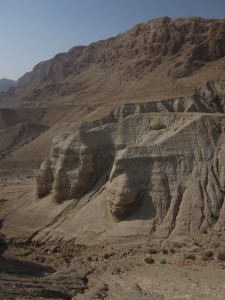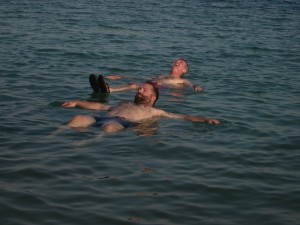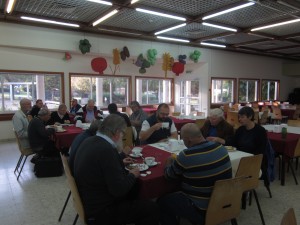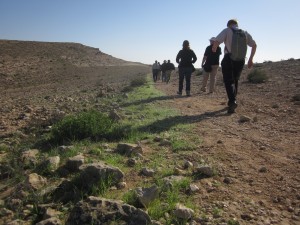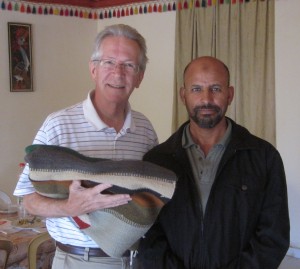Holy people in the history of this land often have withdrawn to the desert, and we Tantur participants ourselves withdrew from November 18-19. When the biblical David was ascending toward the kingship, he was pursued by a jealous King Saul, and took refuge in the caves of En-Gedi. John the Baptist ministered by the Jordan river, and his cousin Jesus himself went into the desert, fasting and praying. On Wednesday morning we drove towards Jericho, turned south, and skirted the Dead Sea until we came to Qumran. The Dead Sea scrolls were discovered there between 1946 and 1947. We learned how much debate there is about the relationship between the scrolls, found in caves in the hills, and the excavations of the city below.
Leaving Qumran, we drove to Masada, the site of a fortress that was enlarged and strengthened by Herod the Great. We rode a tram to the clifftop site, designed to withstand a siege. More than a hundred years after Herod’s death, Jewish rebels against Rome withdrew to the hilltop, and were besieged by the Tenth Roman Legion. When the legion could not starve them out, it constructed a ramp to the hilltop. The rebels, seeing no escape, took their own lives, becoming for many a symbol of Israeli fortitude.
The Dead Sea, the lowest spot on earth, is full of salt, which makes the water especially buoyant. We stopped for lunch at a Dead Sea spa, where several participants tried their luck floating. Some rolled over, their eyes stinging with the salt water, but most were able to keep afloat. We saw African and East European visitors who, after their float, liberally applied the Dead Sea mud to their bodies, then washed them off. It’s supposed to be good for the skin.
That night we visited kibbutz Mashabei Sadeh in the Negev Desert. The kibbutz was founded in 1947, and was attacked by Egypt in 1948, but was retained by Israel. Avigail, a kibbutz member for over 40 years, gave us an introduction to its history. The kibbutz began with traditional agriculture, and unsuccessfuly has tried shrimp and fish farming. One kibbutz industry, Sagiv, produces faucets, ball bearings, and fittings, and it has proven successful for the 400 kibbutz residents.
On Thursday morning we drove from the kibbutz past the town of Yeruham to a spot overlooking Makhtesh Gadol. The name is commonly translated “big crater,” but the 3 x 7 mile “makhtesh” or valley is actually a geological formation caused by erosion. There we reflected for a while on the meaning of the desert experience. While we were overlooking the Makhtesh, we noticed a blimp, floating high over the desert. Our guide said that it is a permanent fixture, for below, in the Makhtesh, is an Israeli nuclear reactor.
We had lunch with Atia al-Atameen, a bedouin man at the unrecognized settlement of Khašim Zannih, his family’s ancestral land. After the 1948 war, most bedouin were forced to relocate to Beer-Sheva, and the Israelis offered them housing. Atia, however, already lived near Beer Sheva, and so did not move. But Israel never recognized his family’s land, which to this day has no electricity. Finally, we visited Tel Beer-Sheva, where the biblical Abraham signed a covenant with Abimelech, offering him gifts, so that the well of Beer-Sheba might be truly his. To learn more, follow me to Qumran.

